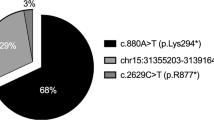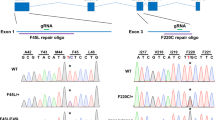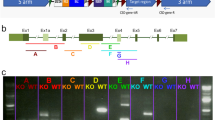Abstract
Oguchi disease is a recessively inherited form of stationary night blindness due to malfunction of the rod photoreceptor mechanism. Patients with this disease show a distinctive golden-brown colour of the fundus that occurs as the retina adapts to light, called the Mizuo phenomenon. Recently a defect in arrestin, a member of the rod phototransduction pathway, was found to cause this disease in some Japanese patients1. As rhodopsin kinase works with arrestin in shutting off rhodopsin after it has been activated by a photon of light, it is reasonable to propose that some cases of Oguchi disease might be caused by defects in rhodopsin kinase. This report describes an analysis of the arrestin and rhodopsin kinase genes in three unrelated cases of Oguchi disease. No defects in arrestin were detected, but all three cases had mutations in the rhodopsin kinase gene. Two cases were found to be homozygous for a deletion encompassing exon 5, predicted to lead to a nonfunctional protein. The third case was a compound heterozygote with two allelic mutations, a missense mutation (Va1380Asp) affecting a residue in the catalytic domain, and a frameshift mutation (Ser536(4-bp del)) resulting in truncation of the carboxy terminus. Our results indicate that null mutations in the rhodopsin kinase gene are a cause of Oguchi disease and extend the known genetic heterogeneity in congenital stationary night blindness.
This is a preview of subscription content, access via your institution
Access options
Subscribe to this journal
Receive 12 print issues and online access
$209.00 per year
only $17.42 per issue
Buy this article
- Purchase on Springer Link
- Instant access to full article PDF
Prices may be subject to local taxes which are calculated during checkout
Similar content being viewed by others
References
Fuchs, S. et al. A homozygous 1-base pair deletion in the arrestin gene is a frequent cause of Oguchi disease in Japanese. Nature Genet. 10, 360–362 (1995).
Carr, R.E. & Gouras, P. Oguchi's disease. Arch Ophthalmol. 73, 646–656 (1965).
Carr, R.E. & Ripps, H. Rhodopsin kinetics and rod adaptation in Oguchi's disease. Invest.Ophthalmol.Vis.Sci. 6, 426–436 (1967).
Berson, E.L. Retinitis pigmentosa and allied diseases, in Principles and Practice of Ophthalmology (eds Albert, D.M. & Jakobiec, F.A.) 1214–1237 (W.B. Saunders, Philadelphia, 1994).
Khani, S.C., Abitbol, M., Yamamoto, S., Maravic-Magovcevic, I. & Dryja, T.P. Characterization and chromosomal localization of the gene for human rhodopsin kinase. Genomics 35, 571–576 (1996).
Inglese, J., Glickman, J.F., Lorenz, W., Caron, M.G. & Lefkowitz, R.J. Isoprenylation of a protein kinase. Requirement of farnesylation/alpha-carboxyl methylation for full enzymatic activity of rhodopsin kinase. J.Biol.Chem. 267, 1422–1425 (1992).
Inglese, J., Koch, W.J., Caron, M.G. & Lefkowitz, R.J. Isoprenylation in regulation of signal transduction by G-protein-coupled receptor kinases. Nature 359, 147–150 (1992).
Palczewski, K., Rispoli, G. & Detwiler, P.B. The influence of arrestin (48K protein) and rhodopsin kinase on visual transduction. Neuron 8, 117–126 (1992).
Ohguro, H., Van Hooser, J.P., Milam, A.M. & Palczewski, K. Rhodopsin phosphorylation and dephosphorylation in vivo. J.Biol.Chem. 270, 14259–14262 (1995).
Rushton, W.A.H. Dark adaptation and the regeneration of rhodopsin. J.Physiol. 56, 166–178 (1961).
Baylor, D.A., Nunn, B.J. & Schnapf, J.L. The photocurrent, noise and spectral sensitivity of rods of the monkey Macaca fascicularis. J.Physiol. 357, 575–607 (1984).
Penn, R.D. & Hagins, W.A. Kinetics of the photocurrent of retinal rods. Biophys.J. 12, 1073–1094 (1972).
Fulton, A.B. et al. The quantity of rhodopsin in human eyes. Curr.Eye.Res. 9, 1211–1216 (1990).
van Kuijk, F.J.G.M., Lewis, J.W., Buck, P., Parker, K.R. & Kliger, D.S. Spectrophotometric quantitation of rhodopsin in human retina. Invest.Ophthalmol.Vis.Sci. 32, 1962–1967 (1991).
Curcio, C.A., Sloan, K.R., Kalina, R.E. & Hendrickson, A.E. Human photoreceptor topography. J.Comp.Neurol. 292, 497–523 (1990).
Dryja, T.P., Berson, E.L., Rao, V.R. & Oprian, D.D. Heterozygous missense mutation in the rhodopsin gene as a cause of congenital stationary night blindness. Nature Genet. 4, 280–283 (1993).
Sieving, P.A., Richards, J.E., Naarendorp, F., Bingham, E.L., Scott, K. & Alpern, M., Model for nightblindness from the human rhodopsin Gly-90→Asp mutation. Proc.Natl.Acad.Sci.USA 92, 880–884 (1995).
Gal, A., Orth, U., Baehr, W., Schwinger, E. & Rosenberg, T. Heterozygous missense mutation in the rod cGMP phosphodiesterase β-subunit gene in autosomal dominant stationary night blindness. Nature Genet 7, 64–68 (1994).
Dryja, T.P., Hahn, L.B., Reboul, T. & Arnaud, B. Missense mutation in the gene encoding the αsubunit of rod transducin in the Nougaret form of congenital stationary night blindness. Nature Genet 13, 358–360 (1996).
Orita, M, Iwahana, H., Kanazawa, H., Hayashi, K & Sekiya, T. Detection of polymorphisms of human DNA by gel electrophoresis as single-strand conformation polymorphisms. Proc.Natl.Acad.Sci.USA 86, 2766–2770 (1989).
Nakamura, Y. et al. Variable number of tandem repeat (VNTR) markers for human gene mapping. Science 235, 1616–1622 (1987).
Author information
Authors and Affiliations
Corresponding author
Rights and permissions
About this article
Cite this article
Yamamoto, S., Sippel, K., Berson, E. et al. Defects in the rhodopsin kinase gene in the Oguchi form of stationary night blindness. Nat Genet 15, 175–178 (1997). https://doi.org/10.1038/ng0297-175
Received:
Accepted:
Issue Date:
DOI: https://doi.org/10.1038/ng0297-175
This article is cited by
-
Central serous chorioretinopathy with a golden sheen
Eye (2024)
-
Genetic analysis and clinical features of three Chinese patients with Oguchi disease
Documenta Ophthalmologica (2023)
-
Mutation analysis reveals novel and known mutations in SAG gene in first two Egyptian families with Oguchi disease
BMC Ophthalmology (2022)
-
Genome-wide analysis of retinal transcriptome reveals common genetic network underlying perception of contrast and optical defocus detection
BMC Medical Genomics (2021)
-
Natural human knockouts and Mendelian disorders: deep phenotyping in Italian isolates
European Journal of Human Genetics (2021)



